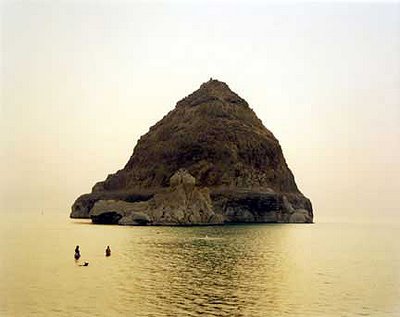
Richard Misrach
(American, b. 1949)
Swimmers, Pyramid Lake Indiana Reservation, Nevada, 1987-93
(American, b. 1949)
Swimmers, Pyramid Lake Indiana Reservation, Nevada, 1987-93
Richard Misrach’s dedication to the Southwest’s desert at first seems to echo a landscape documentary tradition more than the social-documentary work with which he began his career. Yet Misrach’s lifetime project, the Desert Cantos series, with its individual segments divided up between the terrain, events (the landing of a space shuttle, military testing), floods, and fires, has as much to do with social issues as with man’s presence within nature. Begun in 1979, the Desert Cantos series takes its name from its location and the structural term for a subsection of a long song or poem. The cantos vary in subject matter, the amount of time they span, and the number of works in the final grouping. Misrach thinks of all his desert pictures as part of a single great work, divided into cantos by smaller themes, each canto numbered as it is completed. The first fourteen cantos, in order, are: The Terrain, The Event, The Flood, The Fires, The War (Bravo 20), The Pit, Desert Seas, The Event II, Project W-47 (The Secret), The Test Site, The Playboys, Clouds, The Inhabitants, and The Visitors. Stranded Rowboat, Salton Sea is from the third canto, The Flood. The Salton Sea was an ancient, dried-up lake before it was purposely flooded in the early twentieth-century as part of local land-management policies. Misrach uses the lush desert palette to paint an elegant picture of the strangeness and upset balance of human activity in an alien landscape.
Misrach works primarily in the deserts of the American Southwest compiling a sequence of monumental photographic studies that scan the ebb and flow of human intervention in the landscape, but White Man Contemplating Pyramids, Egypt maintains these concerns while taking them to another continent and another culture. As a historical site, the pyramids in this picture have a legacy of construction and destruction. Pyramid builders leveled the site for the tomb of Chafra (the pyramid whose northwest corner is in the foreground), leaving a ten meter drop between the original plateau and the man-made terrace below. Though the smooth blocks of limestone that originally cased the pyramid have since been stripped away, the pavement marks the pyramid’s original footprint. In the distance stands the pyramid of Menkaure, a great gash still visible on the north side where 12th c. explorers attempted to find the entrance to the royal tomb.
Misrach’s first and only trip to Egypt was in 1989 on commission for a German magazine and made with the intention of creating an Egyptian body of work to serve as a “prologue” to the Desert Cantos begun more than a decade earlier. White Man Contemplating Pyramids, Egypt quotes a picture by Maxime Du Camp (French, 1822-1894), one of the first photographers to work in Egypt, but whereas Du Camp sought to make a scientific document, Misrach confronts the political. The tiny figure in the center of the picture certainly references the landscape tradition of using people for scale, but the title charges the scene the scene with issues of race and otherness. It is perhaps interesting to note that the series Misrach produced from this trip includes the similarly named but racially ambiguous Woman Contemplating Ramses, Egypt. White Man Contemplating Pyramids, Egypt was published by LaSalle Bank in 2000 and exhibited in 2001 and 2002 as part of Angle of Repose: Four American Photographers in Egypt, also featuring the work of Linda Connor, Lynn Davis, and Tom Van Eynde.
Born in 1949, Misrach received his BA in psychology from the University of California, Berkeley. He first saw photography as a means to social change, an ideology evident in his first major photographic project, Telegraph 3AM which documented Berkeley’s homeless population. Misrach’s work is represented in over fifty institutional collections, including that of The Metropolitan Museum of Art, New York; The Museum of Modern Art, New York; and the Musée National d’Art Moderne, Paris. His photographs have also been exhibited worldwide, including his first major retrospective, a touring exhibition organized in 1997 by ihe Museum of Fine Arts, Houston.
— Kendra Greene











